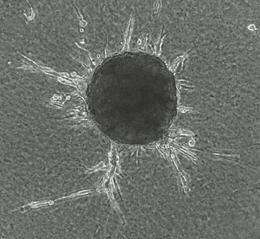New tumor suppressor gene identified

A recent study published in Clinical Cancer Research suggests that the protein hVps37A suppresses tumor growth in ovarian cancer. The work, which was funded by the Austrian Science Fund FWF, shows, for the first time, that this protein is significantly reduced in ovarian cancer cells. The scientists also found that this reduction affects a cellular signalling pathway that is associated with the membrane receptor EGFR (Epidermal Growth Factor Receptor). The receptor is considered an important biological marker for the course of the disease and therapy, and also serves as a target for modern treatment of different cancer types. In fact, the cells in which hVps37A synthesis was reduced showed resistance to Cetuximab, an approved substance for inhibition of EGFR activity.
The hVps37A gene as such is not unknown to scientists. In the period 2004 to 2007, a systematic genome search as part of a project funded by the Austrian Science Fund FWF determined that, among others, this gene is down-regulated in ovarian cancer. The then head of studies, Prof. Michael Krainer, has now studied the function of this gene further in this particular type of cancer. The published results of this follow-up project show that hVps37A is a hitherto unknown tumour suppressor gene.
Receptor for Success
With reference to the study, Prof. Krainer, Director of the Molecular Genetics Working Group, Department of Oncology, University Clinic for Internal Medicine I, Vienna General Hospital, explains: "Our results, which are based on an unparalleled number of tissue samples from ovarian cancer, clearly confirm a significant reduction of hVps37A activity. At the same time, we found that this reduced activity strongly influences the activity of the membrane receptor EGFR. This is an essential indication of the function of hVps37A – and of the importance of our results for other cancer types, in which EGFR activity causes cancer to develop."
The Epidermal Growth Factor Receptor (EGFR) "transmits" signals from the extracellular domain to within the cell. The binding of signal substances on the cell surface of the receptor causes a chemical modification (phosphorylation) of the receptor structure on the side of the cell lumen. This signal subsequently affects numerous cellular processes significantly, including cell proliferation, and may therefore contribute to the development of cancer.
Effective Degradation
In a further key experiment, Prof. Krainer’s team was able to show that the proportions of activated and inactive EGFR in certain ovarian cancer cells were clearly adjusted when hVps37A activity was reduced. According to Prof. Krainer, "this result shows that hVps37A plays a crucial role in degrading the activated form of EGFR. In hVps37A-deficient cells, the activated form of EGFR is no longer degraded and therefore continues to greatly affect subsequent cellular processes – something that hVps37A would inhibit." Indeed, it is commonly known that a protein similar to hVps37A is responsible for disposing of certain "obsolete" proteins in membrane vesicles in yeast cells. Prof. Krainer is of the opinion that the human version of the protein could have a similar role to play.
This theory would explain another result found by Prof. Krainer’s group, namely that cancer cells with reduced hVps37A activity become resistant to Cetuximab, but not to Lapatinib. Cetuximab inhibits EGFR-mediated signal transduction; however, the Cetuximab-EGFR complex must then be degraded in order for the therapy to remain effective. In the case of Lapatinib, which directly inhibits EGFR phosphorylation, this is not necessary.
On the whole, the results from this FWF project offer the first fundamental description of a previously unknown tumor suppressor gene in ovarian cancer cells. Its effect on the EGF receptor also makes the tumour suppressor gene relevant for other types of cancer.
More information: Originalpublikation: hVps37A Status Affects Prognosis and Cetuximab Sensitivity in Ovarian Cancer. M. Wittinger, et al. Clinical Cancer Research 2011;17:7816-7827 DOI:10.1158/1078-0432.CCR-11-0408

















